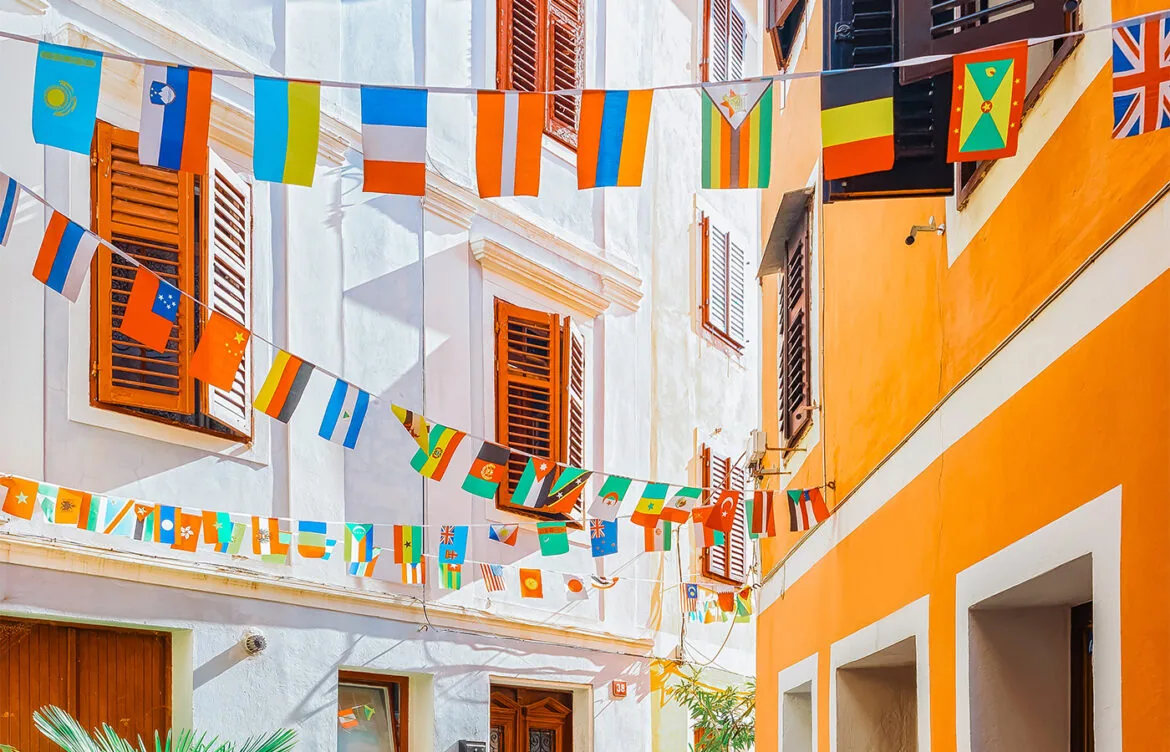The best part about learning Italian is meeting new people and making new friendships. One of the first things you talk about are your origins! When getting to know each other, you’ll ask essential Italian phrases like: di dove sei? (where are you from?), and dove abiti? (where do you live?). To answer (and understand) these questions, you need to learn the names of different countries in Italian, plus their respective nationalities. Some of which are obvious while others not so much (I’m looking at you Germany). More on this later!
In this guide we’ll look at a few simple Italian grammar rules to follow which will give you the keys to unlocking how to say 170+ different countries and nationalities in Italian. We’ll look at how these change according to gender (masculine and feminine) and number (singular and plural).
We’ll also take a look at a handful of rule-breaking nations who are exceptions to the standard grammar rules. But after learning my top tips, you’ll master them in no time. And to bring it all home, I’ve included a fun interactive quiz at the end of this guide so you can practice your new-found Italian grammar and vocabulary skills.
Tuffiamoci! (Let’s dive in!)
Masculine and Feminine Forms
In Italian, every noun, including nationalities, has a grammatical gender – either masculine or feminine. Italian uses suffixes, such as -ese/i, -ano/a, -ino/a and others which are added to the end of a country name to form the nationality.
For example:
- a male from Italy is referred to as an italiano, while a female counterpart is italiana
- a German man is called tedesco while a German woman is tedesca.
Attenzione! Notice how these nationalities are written in lowercase. This will be explained in detail later.
There are, of course, some exceptions. Nationalities ending in -ese, such as francese (French), do not change in gender, only in number.For example:
- One French woman or man is francese, but…
- Two or more French women or men are called francesi
Countries in Italian and their gender
What’s interesting is that in Italian grammatical gender, a significant number of countries are considered feminine singular, such as l’Italia (Italy), la Francia (France), or la Cina (China).
However, there are some exceptions to this. Countries like il Canada (Canada) or il Giappone (Japan) are considered masculine singular..
Then we have countries in the plural like gli Stati Uniti (The United States) or i Paesi Bassi (the Netherlands). Luckily, these are also plural in English which makes them easier to remember.
Learning both the country name and their definite articles (il/la/li/i/gli) can make a huge difference to remembering the correct gender.
Here are some examples sentences:
- La Cina illumina con le sue luci notturne. (China lights up with its night lights.)
- L’Italia è famosa per la sua cucina. (Italy is famous for its cuisine.)
- I Paesi Bassi sono noti per i loro mulini a vento. (The Netherlands are known for their windmills.)
How to say Nationalities in Italian (and when to use capital letters)
Once you know how to say the name of a country in Italian, this will naturally propel you towards intuitively knowing how to say its nationality and the language spoken there too!
Attenzione! Unlike in English where we capitalize the first letter of country names, nationalities and its language, in Italian we only capitalize the first letter of the country.
For example, when referring to citizens of any given nation, in Italian we do not capitalize the first letter:
- Gli spagnoli ed i francesi sono vicini (The Spanish and the French are neighbours)
This is the same for adjectives, even those denoting nationality, which remain lowercase:
- Una ragazza spagnola beve un caffè francese (A Spanish girl drinks a French coffee).
Here is a summary:
| Country (Capitalised) | Nationality (Lowercase) | Descriptive Adjective Form (Lowercase) |
|---|---|---|
| La Spagna (Spain) | uno spagnolo, una spagnola (a Spaniard) | spagnolo (Spanish) |
| La Francia (France) | un francese / una francese (a French man/woman) | francese (French) |
| La Giappone (Japan) | un giapponese, una giapponese (a Japanese man/woman) | giapponese (Japanese) |
Using suffixes to form different nationalities in Italian
There are various suffixes used to convert country names to adjectives. The most common are:
- -ano/ana – messicano (Mexican), americana (American)
- -ese – francese (French), giapponese (Japanese)
Earlier, I alluded to how Germany is an exception to the rule. As a country it’s called la Germania, however a German person is tedesco/a. A similar irregularity is true for il Belgio (Belgium) while a person from Belgium (either male or female) is belga:
- Lui è belga (He is Belgian)
- Lei è belga (She is Belgian)
Don’t let these exceptions throw you off. On the plus side, they are mostly associated with the most popular nations and nationalities, which means you’ll get lots of practice using them!
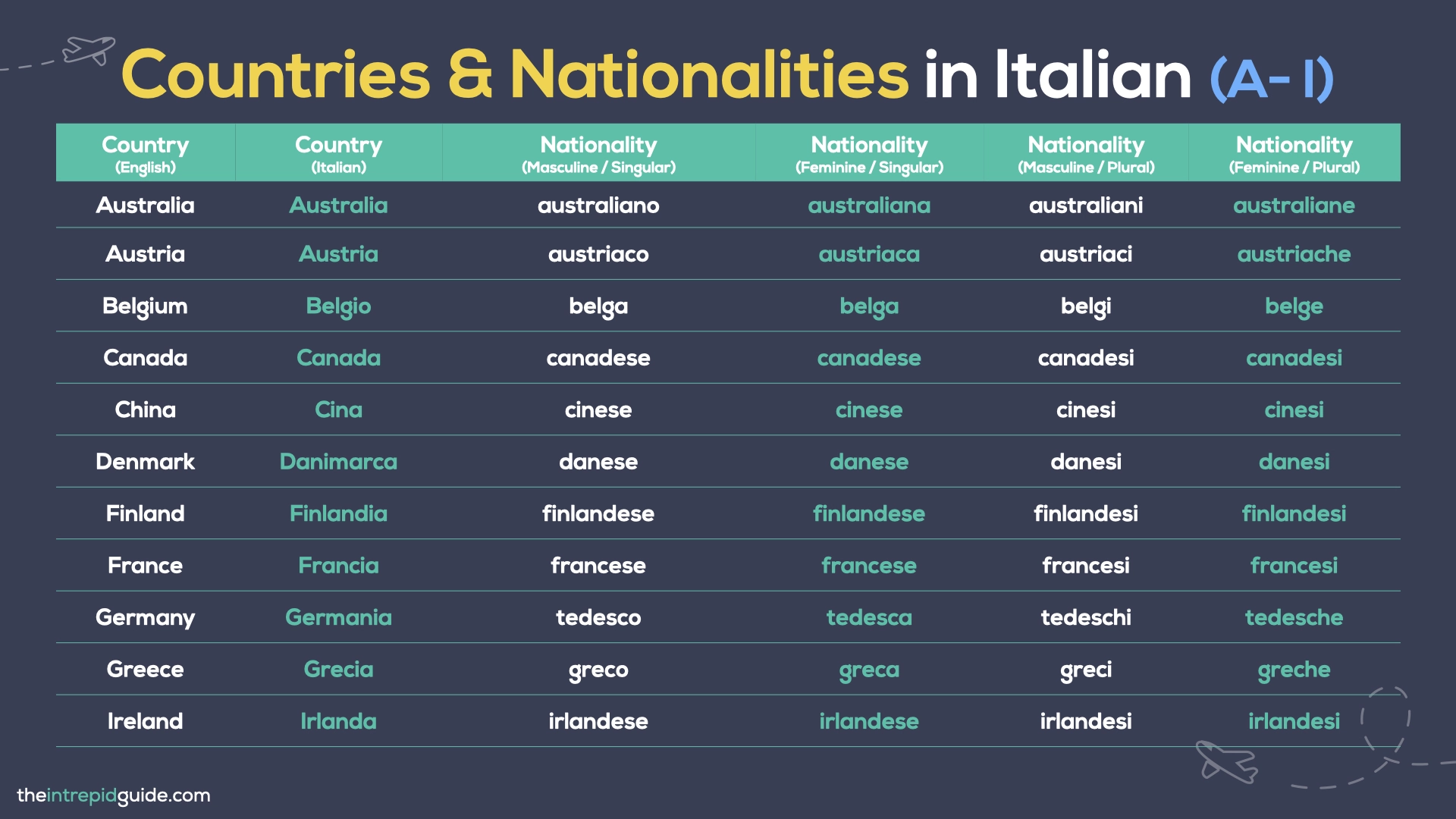
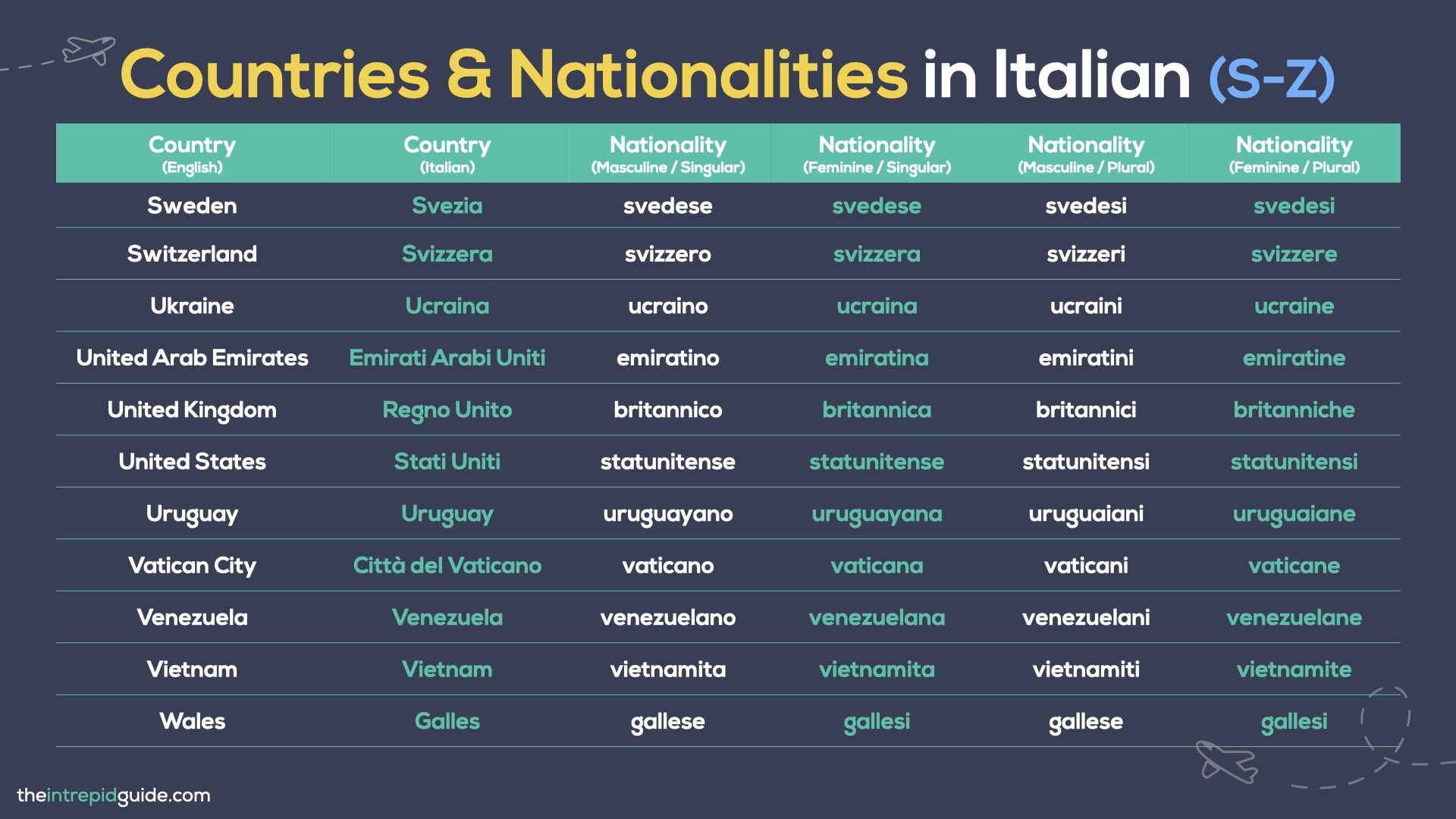
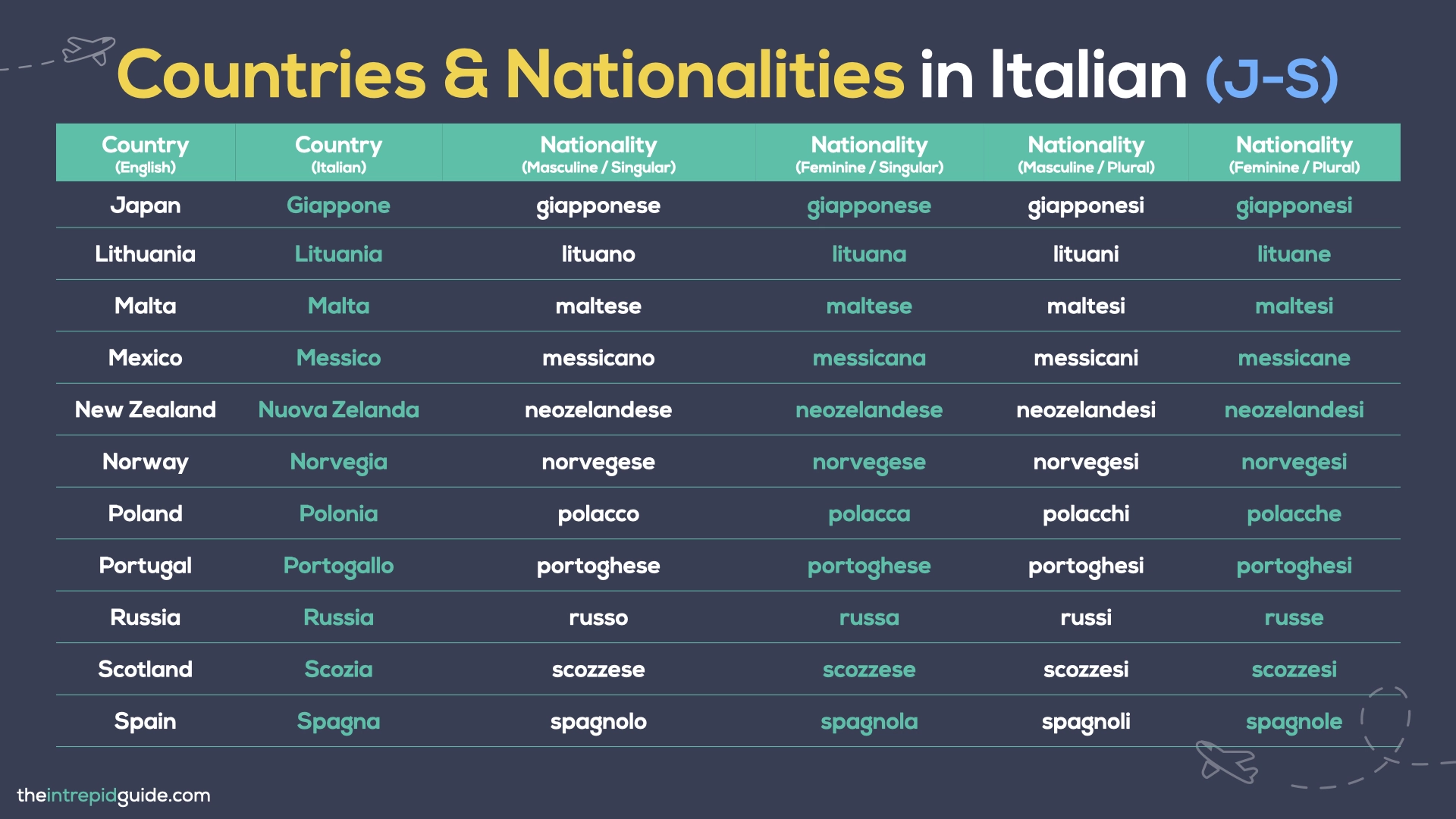
Continents in Italian
- Europe → L’Europa (Feminine) its people are called europei.
- Asia → L’Asia (Feminine) its people are called asiatici.
- Africa → L’Africa (Feminine) its people are called africani.
- America → L’America (Feminine) its people are called americani.
- Oceania → L’Oceania (Feminine). Interestingly, Italians often, albeit inaccurately, call people from Oceania Australiani, even if they hail from New Zealand (Nuova Zelanda → neozelandesi).
- Antarctica → L’Antartide
Cardinal directions in Italian
When referring to geographical areas, using cardinal directions are crucial:
- North: Designated as Il nord or alternatively as Il settentrione/settentrionale.
- South: Called Il sud or the more elaborate Il meridione/meridionale.
- East: Known as L’est or its variant L’oriente/orientale.
- West: Termed L’ovest or the nuanced L’occidente/occidentale.
How to ask: Where do you come from?
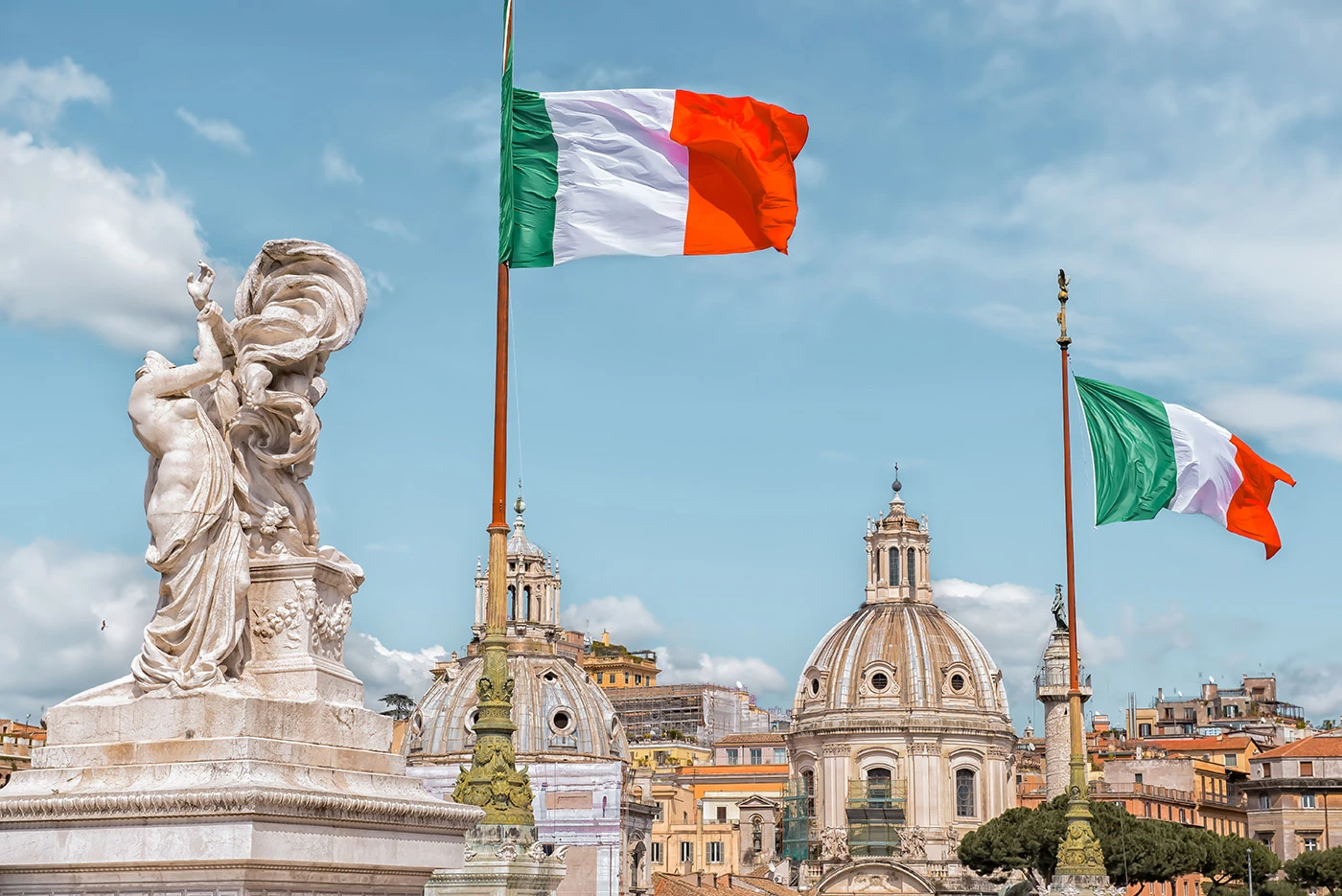 If you want to talk about your place of origin, you can use adjectives denoting nationalities. When using adjectives, they must agree in number and gender of the person.
If you want to talk about your place of origin, you can use adjectives denoting nationalities. When using adjectives, they must agree in number and gender of the person.
If the subject is male you use -o (singular) and -i (plural) and for females you use the endings in -a (singular) and -e (plural). Adjectives that end in -e in the singular refer to both males and females and end in the plural with -i.
For example:
- Siete americani? – Are you Americans?
- Sei australiano? – Are you Australian? [male]
- Sei australiana? – Are you Australian? [female]
- Sono inglese – I’m English/British [male/female]
- Sono irlandese – I’m Irish [male/female]
- Siamo canadesi – We’re Canadians [females, males or a mixed group)
What usually follows when first meeting someone new is asking them where they come from. For this, there are two common questions you can ask using the verbs venire (to come) and essere (to be):
- Da dove viene? – Where do you come from? [Formal]
- Da dove vieni? – Where are you from? [Informal]
These both literally mean, ‘From where do you come?’
- Di dov’è? – Where are you from? [Formal]
- Di dove sei? – Where are you from? [Informal]
These both literally mean, ‘of where are you?’
Other ways you ask someone’s origins are with the verb provenire (to originate from), or with essere + originario/a di (to originate from/be native of).
- Da dove provieni? (Where do you come/originate from?)
- Sei originario della Francia? (Are you from France? / Are you a French native?)
You can also essere + nationality as a question, for example:
- Sei tedesca, vero? (You’re German, aren’t you?)
Using the same verb as used in the question, the answers to these questions are as follows:
- Vengo da… (I come from/I’m from)
- Sono di…(I’m from…)
- Provengo da…(I’m native of) – Using this verb is less common
Using the verbs venire and provenire require a little bit more attention because they are followed by the preposition da (from). We will learn more about prepositions in a future module, however, for now it’s enough to know that in Italian, prepositions merge with definite articles of the following noun. For example:
- Vengo + da + l’Australia → Vengo dall’Australia – I come from Australia
- Viene + da + gli Stati Uniti → Viene dagli Stati Uniti – She/He comes from the United States
- Veniamo + da + la Spagna → Veniamo dalla Spagna (We come from Spain)
- Venite + da + il Canada → Venite dal Canada (You come from Canada)
- Vengono + da + le Filippine → Vengono dalle Filippine (They come from the Philippines)
Here are some more examples:
- È di origini britanniche? – No, il mio cuore batte per il Giappone [Formal] (Are British by birth? – No, I resonate with/my heart beats for Japan.)
- Sono un’anima americana, ma le storie dei miei genitori affondano le radici in Cina. (I have an American soul, but tales of my ancestors trace back to China.)
- Da dove provieni? – Le Alpi austriache mi chiamano casa. (Where are you from originally? – The Austrian Alps call me home.)
How to choose the correct preposition
Learning prepositions in any language is a challenge, but here are two simple rules of thumb to follow when using Italian prepositions when talking about places:
- For countries, continents, or islands, use in.
- For cities, use a.
For example
- Quest’anno vado a Venezia per il Carnevale (This year I’m going to Venice for Carnival)
- Sono di Melbourne ma abito in Italia (I’m from Melbourne but I live in Italy.)
Table of Countries and Nationalities in Italian
Using the rules we saw earlier, here is a complete list of country names and nationalities in Italian organised by gender and number. Use this table as a reference to check your answers when completing the exercises mentioned above.
Using the rules we saw earlier, here is a complete list of country names and nationalities in Italian organised by gender and number. Use this table as a reference to check your answers when completing the exercises mentioned above.
| Country (English) | Country (Italian) | Nationality (Masc. Sing.) | Nationality (Fem. Sing.) | Nationality (Masc. Plural) | Nationality (Fem. Plural) |
|---|---|---|---|---|---|
| Afghanistan | Afghanistan | afghano | afghana | afghani | afghane |
| Albania | Albania | albanese | albanese | albanesi | albanesi |
| Algeria | Algeria | algerino | algerina | algerini | algerine |
| Andorra | Andorra | andorrano | andorrana | andorrani | andorrane |
| Angola | Angola | angolano | angolana | angolani | angolane |
| Antigua & Barbuda | Antigua e Barbuda | antiguano | antiguana | antiguani | antiguane |
| Argentina | Argentina | argentino | argentina | argentini | argentine |
| Armenia | Armenia | armeno | armena | armeni | armene |
| Australia | Australia | australiano | australiana | australiani | australiane |
| Austria | Austria | austriaco | austriaca | austriaci | austriache |
| Azerbaijan | Azerbaigian | azero | azera | azeri | azere |
| Bahamas | Bahamas | bahamense | bahamense | bahamensi | bahamensi |
| Bahrain | Bahrain | bahreinita | bahreinita | bahreiniti | bahreinite |
| Bangladesh | Bangladesh | bangladese | bangladese | bangladesi | bangladesi |
| Barbados | Barbados | barbadiano | barbadiana | barbadiani | barbadiane |
| Belarus | Bielorussia | bielorusso | bielorussa | bielorussi | bielorusse |
| Belgium | Belgio | belga | belga | belgi | belge |
| Belize | Belize | beliziano | beliziana | beliziani | beliziane |
| Benin | Benin | beninese | beninese | beninesi | beninesi |
| Bhutan | Bhutan | bhutanese | bhutanese | bhutanesi | bhutanesi |
| Cambodia | Cambogia | cambogiano | cambogiana | cambogiani | cambogiane |
| Cameroon | Camerun | camerunese | camerunese | camerunesi | camerunesi |
| Canada | Canada | canadese | canadese | canadesi | canadesi |
| Cape Verde | Capo Verde | capoverdiano | capoverdiana | capoverdiani | capoverdiane |
| Central African Republic | Repubblica Centrafricana | centrafricano | centrafricana | centrafricani | centrafricane |
| Chad | Ciad | ciadiano | ciadiana | ciadiani | ciadiane |
| Chile | Cile | cileno | cilena | cileni | cilene |
| China | Cina | cinese | cinese | cinesi | cinesi |
| Colombia | Colombia | colombiano | colombiana | colombiani | colombiane |
| Comoros | Comore | comoriano | comoriana | comoriani | comoriane |
| Congo | Congo | congolese | congolese | congolesi | congolesi |
| Costa Rica | Costa Rica | costaricano | costaricana | costaricani | costaricane |
| Croatia | Croazia | croato | croata | croati | croate |
| Cuba | Cuba | cubano | cubana | cubani | cubane |
| Cyprus | Cipro | cipriota | cipriota | ciprioti | cipriote |
| Czech Republic | Repubblica Ceca | ceco | ceca | cechi | ceche |
| Denmark | Danimarca | danese | danese | danesi | danesi |
| Djibouti | Gibuti | gibutiano | gibutiana | gibutiani | gibutiane |
| Dominica | Dominica | dominicano | dominicana | dominicani | dominicane |
| East Timor | Timor Est | timorese | timorese | timoresi | timoresi |
| Ecuador | Ecuador | ecuadoregno | ecuadoregna | ecuadoregni | ecuadoregne |
| Egypt | Egitto | egiziano | egiziana | egiziani | egiziane |
| El Salvador | El Salvador | salvadoregno | salvadoregna | salvadoregni | salvadoregne |
| Equatorial Guinea | Guinea Equatoriale | equatoguineano | equatoguineana | equatoguineani | equatoguineane |
| Eritrea | Eritrea | eritreo | eritrea | eritrei | eritree |
| Estonia | Estonia | estone | estone | estoni | estone |
| Eswatini (Swaziland) | Eswatini | swazi | swazi | swazilandesi | swazilandesi |
| Ethiopia | Etiopia | etiope | etiope | etiope | etiope |
| Fiji | Figi | figiano | figiana | fijiani | fijiane |
| Finland | Finlandia | finlandese | finlandese | finlandesi | finlandesi |
| France | Francia | francese | francese | francesi | francesi |
| Gabon | Gabon | gabonese | gabonese | gabonesi | gabonesi |
| Gambia | Gambia | gambiano | gambiana | gambiani | gambiane |
| Georgia | Georgia | georgiano | georgiana | georgiani | georgiane |
| Germany | Germania | tedesco | tedesca | tedeschi | tedesche |
| Ghana | Ghana | ghanese | ghanese | ghanesi | ghanesi |
| Greece | Grecia | greco | greca | greci | greche |
| Grenada | Grenada | grenadino | grenadina | grenadiani | grenadiane |
| Guatemala | Guatemala | guatemalteco | guatemalteca | guatemaltechi | guatemalteche |
| Guinea | Guinea | guineano | guineana | guineani | guineane |
| Guinea-Bissau | Guinea-Bissau | guineense | guineense | guineani-bissau | guineane-bissau |
| Guyana | Guyana | guyanese | guyanese | guyanesi | guyanesi |
| Haiti | Haiti | haitiano | haitiana | haitiani | haitiane |
| Honduras | Honduras | honduregno | honduregna | honduregni | honduregne |
| Hungary | Ungheria | ungherese | ungherese | ungheresi | ungheresi |
| Iceland | Islanda | islandese | islandese | islandesi | islandesi |
| India | India | indiano | indiana | indiani | indiane |
| Indonesia | Indonesia | indonesiano | indonesiana | indonesiani | indonesiane |
| Iran | Iran | iraniano | iraniana | iraniani | iraniane |
| Ireland | Irlanda | irlandese | irlandese | irlandesi | irlandesi |
| Iraq | Iraq | iracheno | irachena | iracheni | irachene |
| Japan | Giappone | Giapponese | Giapponesi | Giapponese | Giapponesi |
| Kyrgyzstan | Kirghizistan | kirghiso | kirghisa | kirghisi | kirghise |
| Laos | Laos | laotiano | laotiana | laotiani | laotiane |
| Latvia | Lettonia | lettone | lettona | lettoni | lettone |
| Lebanon | Libano | libanese | libanese | libanesi | libanesi |
| Lesotho | Lesotho | lesothiano | lesothiana | lesotiani | lesotiane |
| Liberia | Liberia | liberiano | liberiana | liberiani | liberiane |
| Libya | Libia | libico | libica | libici | libiche |
| Liechtenstein | Liechtenstein | liechtensteinese | liechtensteinese | liechtensteinesi | liechtensteinesi |
| Lithuania | Lituania | lituano | lituana | lituani | lituane |
| Luxembourg | Lussemburgo | lussemburghese | lussemburghese | lussemburghesi | lussemburghesi |
| Macedonia (North Macedonia) | Macedonia (Macedonia del Nord) | macedone | macedone | macedoni | macedone |
| Madagascar | Madagascar | malgascio | malgascia | malgasci | malgasche |
| Malawi | Malawi | malawiano | malawiana | malawiani | malawiane |
| Malaysia | Malesia | malese | malese | malesi | malesi |
| Maldives | Maldive | maldiviano | maldiviana | maldiviani | maldiviane |
| Mali | Mali | maliano | maliana | maliensi | maliensi |
| Malta | Malta | maltese | maltese | maltesi | maltesi |
| Marshall Islands | Isole Marshall | marshallese | marshallese | marshalliani | marshalliane |
| Mauritania | Mauritania | mauritano | mauritaniana | mauritaniani | mauritaniane |
| Mauritius | Mauritius | mauriziano | mauriziana | mauriziani | mauriziane |
| Mexico | Messico | messicano | messicana | messicani | messicane |
| Micronesia | Micronesia | micronesiano | micronesiana | micronesiani | micronesiane |
| Moldova | Moldavia | moldavo | moldava | moldavi | moldave |
| Monaco | Monaco | monegasco | monegasca | monegaschi | monegasche |
| Mongolia | Mongolia | mongolo | mongola | mongoli | mongole |
| Montenegro | Montenegro | montenegrino | montenegrina | montenegrini | montenegrine |
| Morocco | Marocco | marocchino | marocchina | marocchini | marocchine |
| Mozambique | Mozambico | mozambicano | mozambicana | mozambicani | mozambicane |
| Myanmar (Burma) | Myanmar (Birmania) | birmano | birmese | birmani | birmane |
| Namibia | Namibia | namibiano | namibiana | namibiani | namibiane |
| Nauru | Nauru | nauruano | nauruana | nauruani | nauruane |
| Nepal | Nepal | nepalese | nepalese | nepalesi | nepalesi |
| Netherlands | Paesi Bassi | olandese | olandese | olandesi | olandesi |
| New Zealand | Nuova Zelanda | neozelandese | neozelandese | neozelandesi | neozelandesi |
| Nicaragua | Nicaragua | nicaraguense | nicaraguense | nicaraguensi | nicaraguensi |
| Niger | Niger | nigerino | nigerina | nigerini | nigerine |
| Nigeria | Nigeria | nigeriano | nigeriana | nigeriani | nigeriane |
| North Korea | Corea del Nord | nordcoreano | nordcoreana | nordcoreani | nordcoreane |
| Norway | Norvegia | norvegese | norvegese | norvegesi | norvegesi |
| Oman | Oman | omanita | omanita | omaniti | omanite |
| Pakistan | Pakistan | pakistano | pakistanа | pakistani | pakistane |
| Palau | Palau | palauano | palauana | palaesi | palaesi |
| Panama | Panama | panamense | panamense | panamensi | panamensi |
| Papua New Guinea | Papua Nuova Guinea | papuano | papuana | papuani | papuane |
| Paraguay | Paraguay | paraguaiano | paraguaiana | paraguaiani | paraguaiane |
| Peru | Perù | peruviano | peruviana | peruviani | peruviane |
| Philippines | Filippine | filippino | filippina | filippini | filippine |
| Poland | Polonia | polacco | polacca | polacchi | polacche |
| Portugal | Portogallo | portoghese | portoghese | portoghesi | portoghesi |
| Qatar | Qatar | qatariota | qatariota | qatarioti | qatariote |
| Romania | Romania | rumeno | rumena | rumeni | rumene |
| Russia | Russia | russo | russa | russi | russe |
| Rwanda | Ruanda | ruandese | ruandese | ruandesi | ruandesi |
| Saint Kitts and Nevis | Saint Kitts e Nevis | kittitiano | kittitiana | kittitian e nevisiani | kittitian e nevisiane |
| Saint Lucia | Santa Lucia | santaluciano | santaluciana | luciani | luciane |
| Saint Vincent and the Grenadines | Saint Vincent e Grenadine | vincentino | vincentina | vincentiani | vincentiane |
| Samoa | Samoa | samoano | samoana | samoani | samoane |
| San Marino | San Marino | sammarinese | sammarinese | sammarinesi | sammarinesi |
| Sao Tome and Principe | Sao Tomé e Príncipe | saotomense | saotomense | sao tomeani | sao tomeane |
| Saudi Arabia | Arabia Saudita | saudita | saudita | sauditi | saudite |
| Scotland | Scozia | scozzese | scozzese | scozzesi | scozzesi |
| Senegal | Senegal | senegalese | senegalese | senegalesi | senegalesi |
| Serbia | Serbia | serbo | serba | serbi | serbe |
| Seychelles | Seychelles | seicellese | seicellese | seicellesi | seicellesi |
| Scotland | Scozia | scozzese | scozzesi | scozzese | scozzesi |
| Sierra Leone | Sierra Leone | sierra leonese | sierra leonese | sierra leonesi | sierra leonesi |
| Singapore | Singapore | singaporiano | singaporiana | singaporensi | singaporensi |
| Slovakia | Slovacchia | slovacco | slovacca | slovacchi | slovacche |
| Slovenia | Slovenia | sloveno | slovena | sloveni | slovene |
| Solomon Islands | Isole Salomone | salomonese | salomonese | solomoniani | solomoniane |
| Somalia | Somalia | somalo | somala | somali | somale |
| South Africa | Sudafrica | sudafricano | sudafricana | sudafricani | sudafricane |
| South Korea | Corea del Sud | sudcoreano | sudcoreana | sudcoreani | sudcoreane |
| South Sudan | Sud Sudan | sudsudanese | sudsudanese | sudsudanesi | sudsudanesi |
| Spain | Spagna | spagnolo | spagnola | spagnoli | spagnole |
| Sri Lanka | Sri Lanka | sri lankese | sri lankese | singalesi | singalesi |
| Sudan | Sudan | sudanese | sudanese | sudanese | sudanese |
| Suriname | Suriname | surinamese | surinamese | surinamesi | surinamesi |
| Swaziland (Eswatini) | Swaziland (Eswatini) | swazilandese | swazilandese | swazilandesi | swazilandesi |
| Sweden | Svezia | svedese | svedese | svedesi | svedesi |
| Switzerland | Svizzera | svizzero | svizzera | svizzeri | svizzere |
| Taiwan | Taiwan | taiwanese | taiwanese | taiwanese | taiwanese |
| Tajikistan | Tagikistan | tagiko | tagika | tagiki | tagike |
| Tanzania | Tanzania | tanzaniano | tanzaniana | tanzaniani | tanzaniane |
| Thailand | Thailandia | thailandese | thailandese | thailandesi | thailandesi |
| Togo | Togo | togolese | togolese | togolesi | togolesi |
| Tonga | Tonga | tongano | tongana | tongani | tongane |
| Trinidad and Tobago | Trinidad e Tobago | trinitense | trinitense | trinidegni e tobaghesi | trinidegne e tobaghesi |
| Tunisia | Tunisia | tunisino | tunisina | tunisini | tunisine |
| Turkey | Turchia | turco | turca | turchi | turche |
| Turkmenistan | Turkmenistan | turkmeno | turkmena | turkmeni | turkmeni |
| Tuvalu | Tuvalu | tuvaluano | tuvaluana | tuvalani | tuvalane |
| Uganda | Uganda | ugandese | ugandese | ugandesi | ugandesi |
| Ukraine | Ucraina | ucraino | ucraina | ucraini | ucraine |
| United Arab Emirates | Emirati Arabi Uniti | emiratino | emiratina | emiratini | emiratine |
| United Kingdom | Regno Unito | britannico | britannica | britannici | britanniche |
| United States | Stati Uniti | statunitense | statunitense | statunitensi | statunitensi |
| Uruguay | Uruguay | uruguayano | uruguayana | uruguaiani | uruguaiane |
| Uzbekistan | Uzbekistan | uzbeco | uzbeka | uzbechi | uzbeche |
| Uganda | Uganda | ugandese | ugandese | ugandesi (repeated) | ugandesi (repeated) |
| Vanuatu | Vanuatu | vanuatuano | vanuatana | vanuatensi | vanuatensi |
| Vatican City | Città del Vaticano | vaticano | vaticana | vaticani | vaticane |
| Venezuela | Venezuela | venezuelano | venezuelana | venezuelani | venezuelane |
| Vietnam | Vietnam | vietnamita | vietnamita | vietnamiti | vietnamite |
| Wales | Galles | gallese | gallesi | gallese | gallesi |
| Yemen | Yemen | yemenita | yemenita | yemeniti | yemenite |
| Zambia | Zambia | zambiano | zambiana | zambiani | zambiane |
| Zimbabwe | Zimbabwe | zimbabwiano | zimbabwiana | zimbabwesi | zimbabwesi |
3 Common Italian errors and how to fix them
Wrong Gender Assignment
A common mistake is to use the masculine form, even when speaking about a female. This is normal as it will take some getting used to making this distinction especially since it doesn’t exist in English and other languages. The key is to practice doing this. Start by writing down plenty of example sentences. Start by using the examples given in this guide and change their gender and number.
Incorrect plurals
In Italian, plurals aren’t formed merely by adding a single unique ending like the ‘s’ in English but they change according to its ending and the gender of the group you’re referring to. For example, tedesco (German) becomes tedeschi (men) and tedesche (women). The more you engage with Italian speakers, listen to Italian media, and practice written exercises, you will begin to internalize rules which will become second nature to you.
Incorrect use of capital letters
As we saw earlier, in English, both the names of countries and nationalities start with capital letters, but in Italian, only the names of countries are capitalized. Nationalities are not. This rule can be confusing for English speakers. Remember this rule when writing in Italian!
4 Techniques for learning countries and nationalities in Italian
The complexity of gender, plurals, and unique Italian forms can be overwhelming, but there are some strategies to simplify the learning curve:
1. Do a labelling exercise
Print a blank world map and stick it on your wall or keep it in a study folder. Regularly test yourself by labeling countries and their corresponding Italian nationality adjective. Over time, increase the number of countries you label to challenge yourself.
2. Practice Italian speakers
Regular conversation with Italians will provide you with natural language input and direct feedback. Also, role playing can be lots of fun too. With a study partner or tutor, enact scenarios where you’re meeting people from different countries. For example: Benvenuto! Sei tedesco? (Welcome! Are you German?). This helps to reinforce vocabulary and practice for real-life conversations.
3. Create flashcards and mnemonics
Use flashcards and mnemonics to memorize genders, plural forms, and exceptions. Flashcards are often used with children but they are just as powerful for adult learners too, especially if you’re a visual learner. When learning a new language, flashcards and games can be very effective!
4. Play a matching Game
Create two sets of cards: one with country names in Italian and the other with nationality adjectives. Shuffle and spread them out, then match the country with its corresponding nationality. Time yourself to add a sense of challenge and track your progress.
5 Grammar Exercises to help you improve
When learning nationality adjectives in Italian, it’s not just about vocabulary. There are several nuances of the grammar to take into account. Here are some exercises you can do to practice these and improve.
1. Gender Agreement
Write a list of male and female names. Next to each name, write the nationality adjective in the correct form. For example: Marco è italiano, Maria è italiana.
2. Plural Forms
Make sentences using the plural forms. For example: Gli studenti sono francesi (The students are French).
3. Definite Articles:
Write down phrases both with and without the article and try to discern when each is appropriate. For example:
- L’Italianoè una lingua bellissima. (Italian is a beautiful language)
- Mia madre è italiana. (My mother is Italian)
4. Prepositions and Nationalities:
Create sentences where you move to a city in a specific country and then return from it, focusing on getting the prepositions right. For example: Vado a Parigi in Francia. Torno da Parigi dalla Francia. (I’m going to Paris in France. I’ll come back from Paris in France).
5. Negations
Write down statements about where someone is from, and then negate them. For example:
- Carla è italiana. (Carla is Italian.) Carla non è italiana. (Carla is not Italian)
- Luigi è francese. (Luigi is French.) Luigi non è francese. (Luigi is not French)
- Maria è spagnola. (Maria is Spanish.) Maria non è spagnola. (Maria is not Spanish)
Conclusion
Learning this list of Italian countries and nationalities and gradually incorporating them into your vocabulary means you’re off to a great start in learning Italian.
How well do you know your Italian nationalities and countries? Take the quiz!
Before leaving, here’s a quiz for you to actively practice what you’ve learned so far. It might seem tricky at first, but with a proper study method and the right amount of practice, knowing how to master these common verbs in Italian will be un gioco da ragazzi (a no-brainer)!
 Are you a beginner or an intermediate Italian learner? Got a trip coming up or want to communicate with your Italian partner or relatives in Italian? Learn Italian with my unique 80/20 method
Are you a beginner or an intermediate Italian learner? Got a trip coming up or want to communicate with your Italian partner or relatives in Italian? Learn Italian with my unique 80/20 method
Registrations are now open to join Intrepid Italian, my new series of online video courses that use my unique 80/20 method. You’ll go from a shy, confused beginner to a proficient and confident intermediate speaker, with me as your trusty guide.
You’ll finally be able to connect with your Italian partner, speak to your relatives and enjoy authentic travel experiences in Italy that you’ve always dreamed of, and so much more.
As a native English speaker who learned Italian as an adult, I know what it’s like to feel hopeless and lack the confidence to speak. I know what it’s like to start from scratch and to even go back to absolute basics and learn what a verb is!
Intrepid Italian was created with YOU in mind. I use my working knowledge of the English language to help you get into the ‘Italian mindset’ so you can avoid the common pitfalls and errors English speakers make – because I made them once too! I break everything down in such a way that it ‘clicks’ and just makes sense.
No matter what your level is, there is an Intrepid Italian course for you, including:
- 🇮🇹 Intrepid Italian for Beginners (A1)
- 🇮🇹 Intrepid Italian for Advanced Beginners (A2)
- 🇮🇹 Intrepid Italian for Intermediates (B1)
You can join 1, 2, or all 3 courses, it’s entirely up to you. The best part is that you have lifetime access so you learn anytime, anywhere and on any device.
As your guide, I walk you through each lesson, step-by-step, using my unique 80/20 method. My approach is different from traditional methods because I teach you the most important 20% of the language right from the beginning so you can start to speak straight away.
Each course includes video lessons, audio exercises, downloadable worksheets, bonus guides, a private support community, and lifetime access all designed to streamline your learning while having fun.
It even comes with my famous “Celebrate with a Spritz Guarantee”. After 30 days of using Intrepid Italian, if you don’t want to celebrate your new-found Italian skills with an Aperol Spritz, you don’t have to pay a penny! Cheers! 🥂
Join Intrepid Italian here and start learning today!
Ci vediamo lì! (See you there!)
Learning Italian? Check out these Italian language guides
- Italian for Beginners | How to Learn Italian in 3 Simple Steps
- TOP 100 Most Common Italian Words (Plus PDF Cheat-Sheet & Quiz)
- Italian Prepositions:The Only Guide You’ll Ever Need (PLUS Chart)
- 17 Weird Italian Superstitions Italians ACTUALLY Live By
- 17 Must-Know Italian Hand Gestures: The Ultimate Guide
- 10 Ways Natives REALLY Say ‘You’re Welcome’ in Italian
- How to say ‘Please’ in Italian in 9 Ways Like a Native
- 41 Italian Greetings: How to Say ‘Hello’ in Italian Like a Local
- 125 Most Common Italian Phrases for Travel You’ll Ever Need [PLUS Printable]
- 8 DEADLY mistakes in Italian (& How to Avoid Them)
- How to Conjugate Italian Verbs in 3 Simple Steps [Italian for Beginners]
- Is Italian Hard to Learn? 7 Common Mistakes & How to Avoid Them
- Master Days of the Week in Italian (7 Simple Memory Hacks)
- Italian Numbers: How to Count in Italian From 0 to 1 Billion (Plus PDF Download)
- How to Order Food & Drinks in Italian [Italian for Beginners]
- 15 Italian Words You Should NEVER Mispronounce [& How Not To]
- 11 Effective Hacks That’ll Help You Learn Italian So Much Faster
- Top 14 Italian Words You Should NEVER Say [& What to Use Instead]
- 20 Hilarious Everyday Italian Expressions You Should Use
- Romanesco: 25 Cool Roman Dialect Words You Should Use in Rome
- 10 Reasons Why Learning Italian Will Change Your Life
- 10 Italian Expressions Italians Love Saying
- 10 Italian Phrases That Will Instantly Make You Sound more Italian
- Funny Italian Sayings: 26 Food-Related Insults You Won’t Forget
- 15 Romantic Italian Films That’ll Make You Love Italy Even More
- How to Master Common Italian Phrases for Travel (Like a Local!)
Like it? Pin it for later!
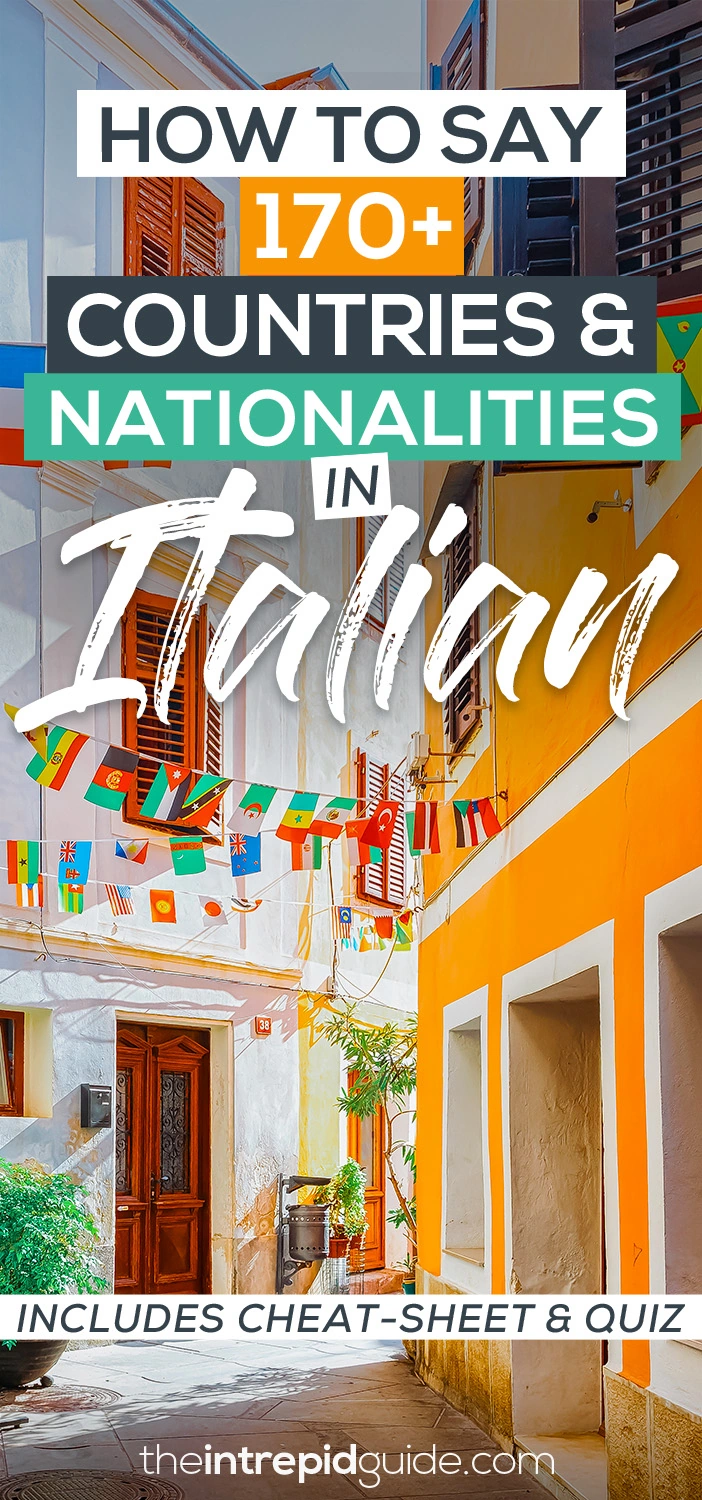
Over to you!
Did you find this guide useful? Let me know using the comments section below or join me on social media @intrepidguide or @intrepiditalian to start a conversation.
Thanks for reading and I hope you enjoyed this post.
Like what you see? Subscribe using the form below to have all of my posts delivered directly to your email.

